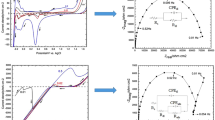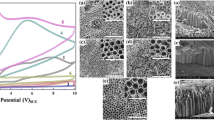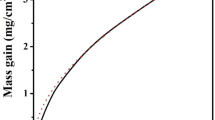Abstract
Anodic film growth on a Ti alloy in water-containing ethylene glycol electrolyte with addition of fluoride (0.016–0.17 mol dm−3) was investigated using electrochemical and surface analytical techniques. Steady-state current–potential curves and electrochemical impedance spectra as depending on potential and fluoride content point to two parallel reaction pathways — film growth/dissolution and titanium dissolution through the film. Chemical composition of the anodic films was estimated by X-ray photoelectron spectroscopy (XPS). A kinetic model of the process is parameterized by quantitative comparison with the current–potential and EIS data, as well as dynamic impedance and photo-current measurements. The main features of the XPS data are also reproduced by the model. Apparent reaction orders of the individual steps with respect to fluoride are also estimated. Electronic carrier dynamics during anodic oxidation was assessed via intensity modulated photocurrent spectroscopy (IMPS) to estimate phenomenological parameters using a generalized transfer function.













Similar content being viewed by others
Abbreviations
- a :
-
Half-jump distance, cm
- b j :
-
Exponential coefficients of charge transfer reactions (j = O, i, 2, 31), V−1
- C sc :
-
Depletion layer capacitance, F cm−2
- C ss :
-
Surface state capacitance, F cm−2
- C H :
-
Helmholtz capacitance, F cm−2
- D e :
-
Diffusion coefficient of electronic current carriers, cm2 s−1
- E :
-
Applied potential, V
- \(\overrightarrow{E}\) :
-
Electric field strength, V cm−1
- I :
-
Current density, A cm−2
- I M :
-
Current density due to cation vacancies, A cm−2
- I O :
-
Current density due to oxygen vacancies, A cm−2
- I 0 :
-
Incident photon flux, photons cm−2 s−1
- J M :
-
Flux of cation vacancies, mol cm−2 s−1
- J O :
-
Flux of oxygen vacancies, mol cm−2 s−1
- k j :
-
Rate constants of the interfacial reactions (j=O, 2O, i, 2i, 1, 2, 31, 32), mol cm−2 s−1
- k d :
-
Rate constant of the film dissolution reaction, cm s−1
- k tr :
-
Rate constant of photo-induced charge transfer (s−1)
- k r :
-
Rate constant of recombination of photo-induced carriers (s−1)
- k rec :
-
Rate constant of ionic defect recombination (s−1)
- L :
-
Thickness of the barrier layer, cm
- m :
-
Metal atom in the alloy
- \({\mathrm{M}}_{\mathrm{M}}^{\mathrm{III}^{\prime}}\) :
-
M(III) in a M(IV) position in the barrier film
- \({\mathrm{M}}_{\mathrm{M}}^{\cdots }\) :
-
M(III) interstitial cation in the barrier film
- O O :
-
Oxygen position in the barrier film
- q j :
-
Rate constants of generalized charge transfer reaction (j = 1–4), s−1
- V O •• :
-
Oxygen vacancy in the barrier film
- V M 4´ :
-
Cation vacancy in the barrier film
- W :
-
Depletion layer width, cm
- α :
-
Polarizability of the film / solution interface
- α j :
-
Transfer coefficient of charge transfer reactions (j = O, i, 2, 31)
- α opt :
-
Optical absorption coefficient, cm−1
- β M :
-
Surface concentration of cation positions, mol cm−2
- β O :
-
Surface concentration of oxygen vacancies at the O/S interface, mol cm−2
- γIII :
-
Fraction of M(III) in M(IV) positions in the outermost layer of the film
- ε :
-
Dielectric constant of the film
- η :
-
Incident photon to current efficiency (IPCE)
- τ ss :
-
Time constant for charging of surface states, s
References
Zwilling V, Aucouturier M, Darque-Ceretti E (1999) Anodic oxidation of titanium and TA6V alloy in chromic media. An electrochemical approach Electrochim Acta 34:921–929
Macak J, Tsuchiya H, Taveira L, Ghicov A, Schmuki P (2005) Self-organized nanotubular oxide layers on Ti-6Al-7Nb and Ti-6Al-4V formed by anodization in NH4F solutions. J Biomed Mater Res Part A 75A:928–933
Shrestha NK, Nah Y-C, Tsuchiya H, Schmuki P (2009) Self-organized nano-tubes of TiO2–MoO3 with enhanced electrochromic properties. Chem Commun 2009:2008–2010
Oliveira NTC, Verdério JF, Bolfarini C (2013) Obtaining self-organized nanotubes on biomedical Ti–Mo alloys. Electrochem Commun 35:139–141
Reis Rangel AL, Moreira Santos GR, Rosifini Alves Claro AP (2016) Nanotubes growth on Ti-15Mo alloys by anodization at low voltage. Mater Sci Forum 869:924–929
Mohan L, Dennis C, Padmapriya N, Anandan C, Rajendran N (2020) Effect of electrolyte temperature and anodization time on formation of TiO2 nanotubes for biomedical applications. Materials Today Communications 23:101103
Zhou X, Nguyen NT, Özkan S, Schmuki P (2014) Anodic TiO2 nanotube layers: why does self-organized growth occur—a mini review. Electrochem Commun 111:106663
Zhou Q, Tian M, Ying Z, Dan Y, Tang F, Zhang J, Zhu J, Zhu X (2020) Dense films formed during Ti anodization in NH4F electrolyte: evidence against the field-assisted dissolution reactions of fluoride ions. Electrochem Commun 46:157–162
Kong DS (2010) Anion-incorporation model proposed for interpreting the interfacial physical origin of the faradaic pseudocapacitance observed on anodized valve metals; with anodized titanium in fluoride-containing perchloric acid as an example Langmuir 26:4880–4891
Kong DS, Kong W-Q, Feng Y-Y, Li W-J, Wie Y-J (2013) A method developed for getting kinetic information from electrochemical impedance spectroscopy measured for anodized Ti in fluoride. J Electrochem Soc 160:C461–C466
Roh B, Macdonald DD (2019) Passivity of titanium: part II, the defect structure of the anodic oxide film. J Solid State Electrochem 23:1967–1979
Roh B, Macdonald DD (2019) The passivity of titanium—part III: characterization of the anodic oxide film. J Solid State Electrochem 23:2001–2008
Roh B, Macdonald DD (2019) Passivity of titanium, part IV: reversible oxygen vacancy generation/annihilation. J Solid State Electrochem 23:2863–2879
Stancheva M, Bojinov M (2012) Influence of fluoride content on the barrier layer formation and titanium dissolution in ethylene glycol–water electrolytes Electrochim. Acta 78:65–73
Stancheva M, Bojinov M (2013) Interfacial and bulk processes during oxide growth on titanium in ethylene glycol-based electrolytes. J Solid State Electrochem 17:1271–1283
Stancheva M, Diawara B, Lebreau F, Bojinov M (2014) Multi-scale modeling of the initial stages of anodic oxidation of titanium. J Electrochem Soc 161:E3188–E3195
Betova I, Bojinov M, Karastoyanov V, Stancheva M (2020) Effect of potential on dissociative adsorption of water on titanium assessed by density functional theory calculations Comput. Mater Sci 171:109260
Betova I, Bojinov M, Karastoyanov V (2020) Modeling barrier film growth and dissolution on titanium based on EIS. XPS and photocurrent data Electrochim Acta 344:136137
Betova I, Bojinov M, Karastoyanov V, Stancheva M (2021) Parameterization and extension of a model of oxide growth by a multi-method approach. J Electrochem Soc 168:031502
Bojinov M, Stancheva M (2015) Coupling between dissolution and passivation revisited – kinetic parameters of anodic oxidation of titanium alloys in a fluoride-containing electrolyte. J Electroanal Chem 737:150–161
Betova I, Bojinov M, Karastoyanov V, Slavcheva E (2020) Characterization and modeling of anodic oxide films on a Ti alloy in fluoride-containing electrolyte. J Electrochem Soc 167:121506
Peter LM, Ponomarev EA, Fermin DJ (1997) Intensity-modulated photocurrent spectroscopy: reconciliation of phenomenological analysis with multistep electron transfer mechanisms. J Electroanal Chem 427:79–96
Acknowledgements
This study is funded by the European Union-NextGenerationEU, through the National Recovery and Resilience Plan of the Republic of Bulgaria, project № BG-RRP-2.004-0002, “BiOrgaMCT”. Part of the measurements were performed within equipment of the National Scientific Infrastructure “Energy Storage and Hydrogen Energy” (ESHER, contract DO1-160/28.08.18).
Author information
Authors and Affiliations
Corresponding author
Additional information
Publisher's Note
Springer Nature remains neutral with regard to jurisdictional claims in published maps and institutional affiliations.
Rights and permissions
Springer Nature or its licensor (e.g. a society or other partner) holds exclusive rights to this article under a publishing agreement with the author(s) or other rightsholder(s); author self-archiving of the accepted manuscript version of this article is solely governed by the terms of such publishing agreement and applicable law.
About this article
Cite this article
Bojinov, M., Betova, I. & Karastoyanov, V. Multi-method characterization of anodic oxidation of a titanium alloy in fluoride-containing electrolytes. J Solid State Electrochem 27, 1835–1846 (2023). https://doi.org/10.1007/s10008-023-05442-9
Received:
Revised:
Accepted:
Published:
Issue Date:
DOI: https://doi.org/10.1007/s10008-023-05442-9




